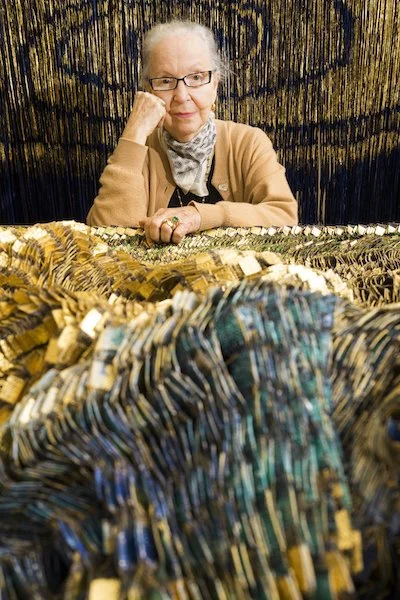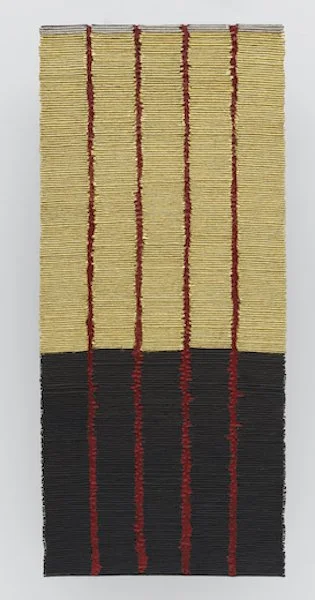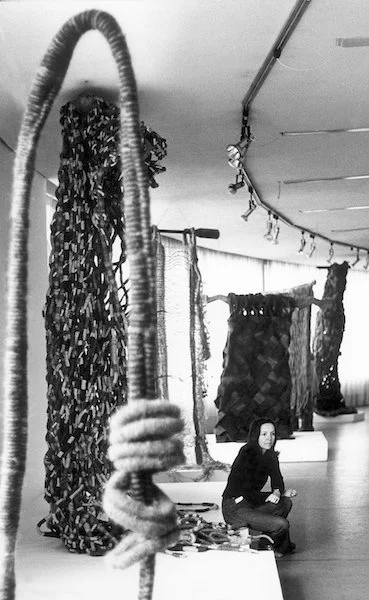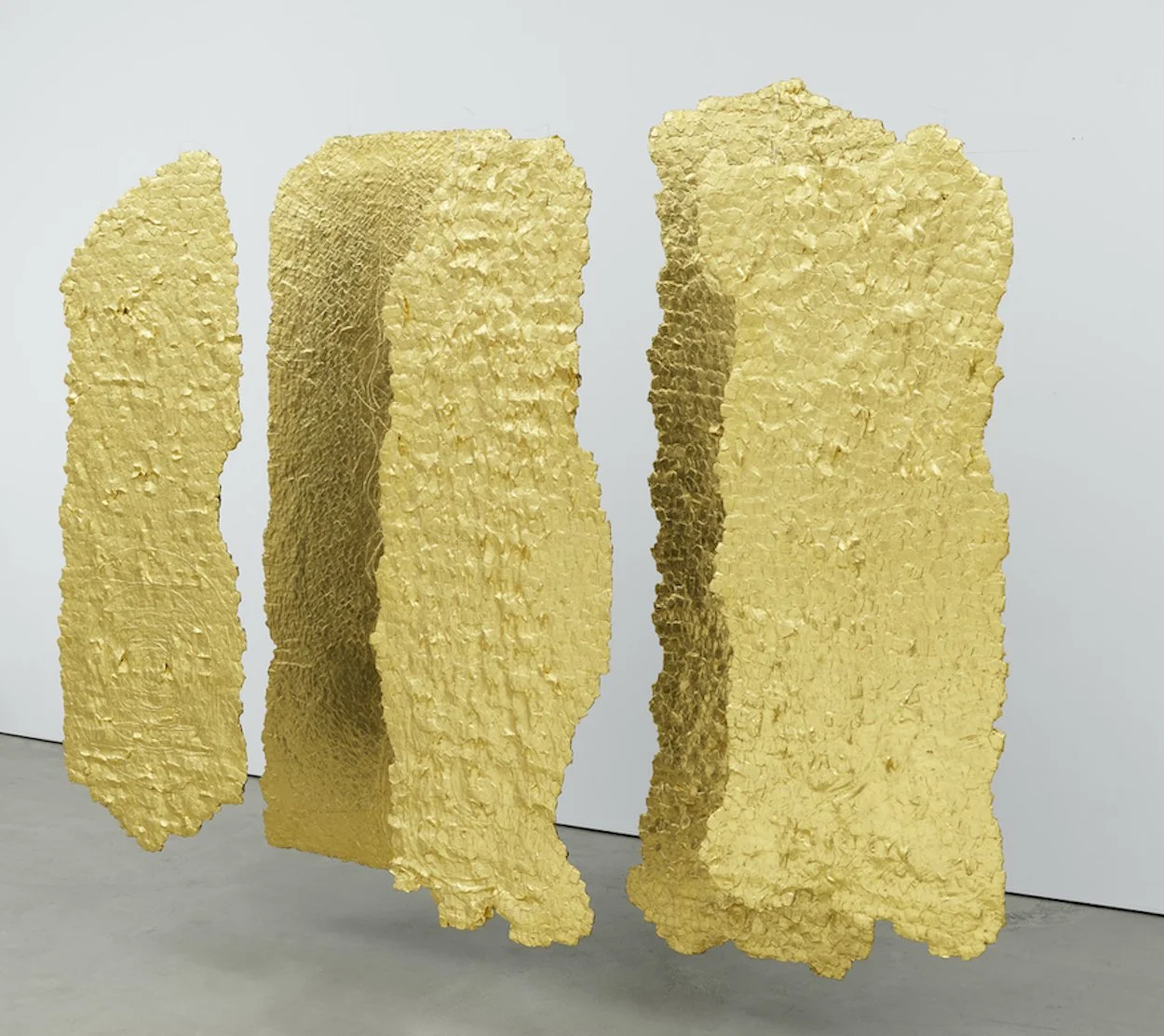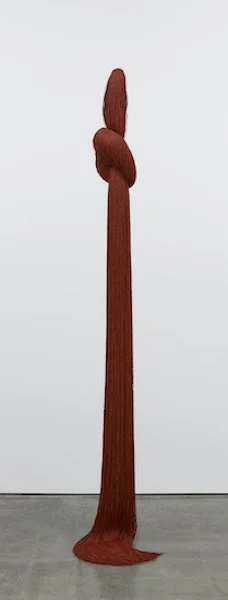Fabric of Impulse: Fiber Artist Olga de Amaral Melds Artistic Spontaneity with Slow Craft
Published in Art in America, December, 2021
By Glenn Adamson
Olga de Amaral, 2015.PHOTO DIEGO AMARAL CEBALLOS
“The mind was following, not guiding.” This is how Olga de Amaral looks back at her own work, from the lofty summit of a nearly seven-decade career. “Very little planning went into it,” she says in her most recent catalogue. “It all happened in the moment, following impulses, the intuitions of the moment that came in the process of doing. My creative language developed in this way. Without conceptualization.”
That approach isn’t unusual for an artist of Amaral’s generation. She started out in the late 1950s, when Abstract Expressionism was still a dominant style, and intuition—what happens “in the moment”—was prized above all else. But Amaral is, principally, a weaver. Her medium tends to a slow and structured progression. It rewards considerable forethought and patient execution. This contrast—between feeling and premeditation, impulse and handiwork—is a central animating dialectic of her work. As she has developed discrete but overlapping idioms, Amaral has consistently achieved what seems impossible: a luxuriantly expansive immediacy. Working at large scale with as many as seven assistants, she somehow manages to create textile art that appears instinctive, direct, and deeply personal.
These qualities shine forth in “To Weave a Rock,” a survey of Amaral’s work now at the Cranbrook Art Museum in Bloomfield Hills, Michigan, through March 20, 2022, and previously shown at the Museum of Fine Arts, Houston. (Another exhibition is currently on view at Lisson Gallery in New York through December 18.) The retrospective’s title, drawn from an assignment that Amaral set her students at the Haystack Mountain School of Crafts in rural Maine in 1967, nicely captures the ambience of her works. They feel not so much made as summoned into being. This is especially true when she uses gold leaf, a signature material she adopted in the 1980s, which turns her fiber works into shimmering apparitions. Amaral emphasized the otherworldly transmutation by calling the series “Alquimias” (Alchemies). The magic has continued in her subsequent “Bosques” (Forests) and “Brumas” (Mists), in which geometric forms appear to hover within diaphanous free falls of threads, as well as her “Nudos” (Knots), bundles of painted threads that stand upright on the ground, as decisive as any painted brushstroke.
Alquimia 42B, 1986, linen, gesso, and gold leaf, 64 7/8 by 27 1/2 in.©️ OLGA DE AMARAL; COURTESY LISSON GALLERY
Amaral’s technology of enchantment (to borrow a phrase from anthropologist Alfred Gell) has developed over the course of an unusually cosmopolitan career. Though the artist has lived and worked principally in Bogotá, Colombia, where she was born in 1932, her professional pathway has been continually shaped by experiences in both the United States and Europe. After initially training in architectural drafting, she went to New York City in 1954 to study English. That fall, she enrolled at the Cranbrook Academy of Art, encouraged by a friend from Colombia, architect Hans Drews. As she recalls in the “To Weave a Rock” catalogue, he told her it was “more than a place to study design and crafts. . . . It was a place that valued freedom.”
Cranbrook’s textile department at the time was led by Marianne Strengell, one of the Nordic talents recruited to the Academy by her fellow Finnish designers, Eliel and Loja Saarinen. Strengell’s approach was definitely applied art: textiles in the service of architecture and industry. When Amaral returned to Colombia after just a year at Cranbrook, she set up a studio operating in that instrumental spirit, producing upholstery and furnishing fabrics as well as a fashion line. It was a full decade before she began creating “fiber art”—a term that hadn’t quite been invented yet.
That moment came in 1964, when Amaral traveled to San Francisco, to visit the family of her American husband. There she met up with fellow Cranbrook graduate, Lillian Elliott, at an unusually exciting time to be a weaver in America. The previous year the Museum of Contemporary Crafts in New York had presented “Woven Forms,” curated by Paul J. Smith as a showcase for Lenore Tawney, along with four other progressive weavers: Alice Adams, Sheila Hicks, Dorian Zachai, and Claire Zeisler. Tawney’s works, in particular, demonstrated a wholly new approach to textiles. They hung freely in space, with warps that traveled in graceful diagonals rather than straight up and down, and passages of openwork to let the light through.
Following Elliott’s initial prompting, Amaral soon formulated her own unique response to these currents. In 1965 she began creating hangings with interlaced forms. These were made on a vertical loom with a split warp. Amaral manipulated the resulting strips laterally, dividing and rejoining them, passing them under and over one another into plaits (done off the loom), sometimes integrating individual wrapped cords. The complex results offer a contrapuntal play against the typical textile grid—a weaving of weavings. Though this was a different technique from the one Tawney had used in her “woven forms,” it resulted in a comparable effect: a complex, rhythmic cascade.
Olga de Amaral, 1968, in an exhibition of her work at the Museo de Arte Moderno, Planetario Distrital de Bogotá.PHOTO DIANA WITLIN
The interlaces positioned Amaral at the forefront of her medium, and she was soon exhibiting internationally. She was included in the 1967 Lausanne Biennial, Europe’s premier event for experimental tapestry, as well as the landmark 1969 exhibition “Wall Hangings,” organized at the Museum of Modern Art, New York, by curator Mildred Constantine and textile designer Jack Lenor Larsen. Smith gave Amaral a show at the Museum of Contemporary Crafts the following year, focusing on her “Woven Walls,” a series of densely crisscrossed works, some of which are curvaceous and embracing in their overall form. At the time, Amaral was also experimenting with plastic—a readily available material that she used to pack her work in the studio—rendering it ethereally translucent by layering it atop itself, as in works like Luz Blanca (White Light), 1969.
The late 1960s were the peak years for fiber art on the international stage, and Amaral was a singular figure in that context. Though many weavers of the era—Tawney, Hicks, and Anni Albers among them—drew inspiration from historic Latin American textiles, Amaral was the only contemporary fiber artist from that part of the world who was of comparable stature. The geographically dispersed practitioners of the emergent field were her creative community; she did not have strong connections to other artists in the region, even those who were exploring abstraction in textiles. (Via email, she explained that she knew the work of the Venezuelan artist Jesús Rafael Soto, but had no relationship with him. Meanwhile, she was unaware of what Hélio Oiticica and Lygia Pape were doing in Brazil.) Her affinities were elsewhere, some elemental and some highly sophisticated. On the one hand, she noted, “I was inspired by women in the countryside preparing the wool. And I loved rocks covered with moss.” On the other, she befriended the great Polish artist Magdalena Abakanowicz (subject of a current exhibition at Tate Modern), whose supremely powerful, heavily textured, often figurative works doubtlessly influenced Amaral in the early 1970s, when the latter executed her pieces mainly in wool and horsehair, and even ventured briefly into freestanding totemic forms.
“Estela” (Wake) grouping, 2018, linen, gesso, acrylic, and gold leaf; each element 61-76 inches high.©️ OLGA DE AMARAL, COURTESY LISSON GALLERY
Knot 28, 2016, linen, gesso and acrylic, 118 by 11 3/4 inches.©️ OLGA DE AMARAL, COURTESY LISSON GALLERY
By the 1980s, the lights dimmed on fiber art. Organic handwrought abstraction, notably macramé, had been a perfect fit for the countercultural era, but it did not suit the media-obsessed, conceptually inclined period that followed. Fortunately, Amaral had light of her own to bring. Her “Alquimias,” particularly, won wide acclaim despite the general malaise afflicting her discipline. She arrived at them gradually, first adding gesso to her weavings (bringing them closer to the material state of paintings) and only later realizing that this move yielded an ideal surface for adding gold leaf. While her use of this precious metal has often been associated with pre-Columbian artifacts, Amaral stresses that she found its attraction primarily formal—a new color in her palette, introducing a play of reflectivity. Her repertoire became more refined in other ways too: she shifted principally to fine linen as a substrate rather than fibrous wool, and embellished threads with acrylic paint and pigmented clays. She also strove to create internal illumination, in ways that again recall Tawney’s works—this time the suspended “Clouds,” with their long, dangling fibers, which marked the culmination of the older artist’s career. Like those ethereal pieces, Amaral’s “Bosques” and “Brumas” are essentially unwoven textiles—warp threads without corresponding wefts, hung vertically to create a color-space.
The “Nudos,” which are among Amaral’s most recent works, are also her most concise. They bring to fruition her long-standing interest in “scaling up of the discrete components of the textile elements,” she remarked in another email. “The beginning of a fabric, the kernel of a textile, is a knot. I wanted to monumentalize this incredible technology.” The comment makes me wonder whether these works might be self-portraits of a kind. Vertically oriented and rising to a hairstyle-like topknot, they certainly could be read as figural. But Amaral says no—she was not thinking about the body when she made them, but about the intrinsic logic of the medium. Rather than self-portraits, then, perhaps it would be better to see them as statements of purpose, materialized manifestos, the exclamation marks of a long and amazingly generative career. When it comes to summarizing all she has achieved, it would be hard to put the case better than Amaral does herself: “I wanted to make the thread and the knot more visible, giving them the weight, the importance they deserve.”
